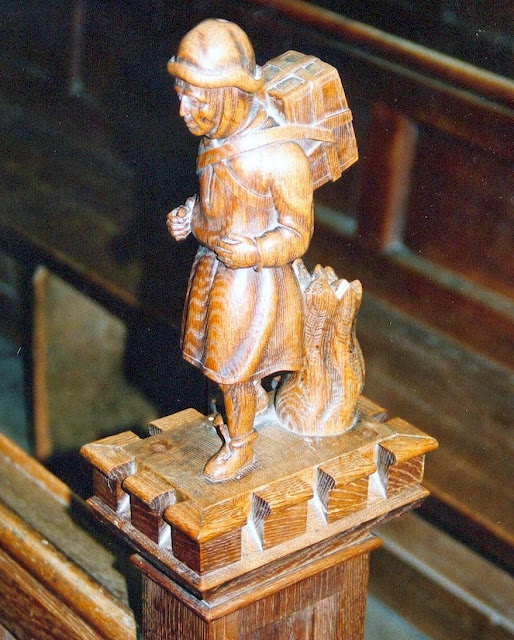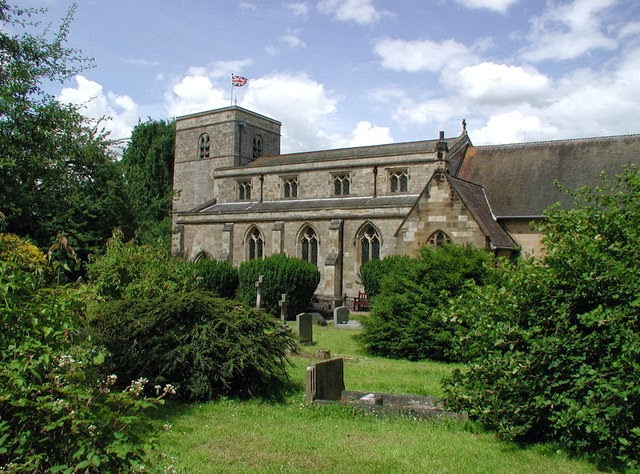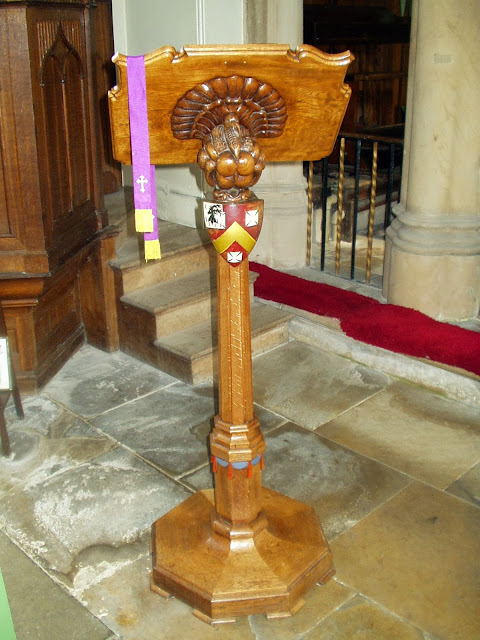This page is about unusual and interesting church stories.
Where saints have trod
The church at Lastingham near Pickering in North Yorkshire
is one of the earliest seats of religion in the north of England and as a village
church is quite unique. The earliest
details come from the Venerable Bede who tells us that St Cedd, who was Bishop
of East Anglia, came here in the 7th century to found a church where
King Ethelwald of Northumbria might worship and find a last resting place. The first church was built c659AD and is the
shrine of St Cedd who bequeathed the abbacy of his church to his brother
Chad. Chad subsequently became Bishop of
York and then Lichfield where he was buried and venerated as a Saint.
Little is known of the later history of this church until
1078, when Abbot Stephen of Whitby Abbey began to rebuild Cedd’s church. It was such a wild and lawless place that
Stephen eventually abandoned the work and went to York where he founded St
Mary’s Abbey instead, leaving the legacy which is the main part of Lastingham
church as we see it today. Stephen had
first built a stone crypt which is a little church in itself, with a chancel,
nave and side aisles and a unique apse, which has remained unchanged to the
present time. It is thought that St
Cedd was buried on the right side of the altar and it is possible that the
crypt was also the last resting place of King Ethelwald. Although Stephen’s plans for a great Abbey
church were not completed, the crypt and the east end of the church were
eventually incorporated into the unique present day church which was completed
in 1228 and restored in 1879.
 |
The Crypt
In 1774 the Curate of Lastingham church, the
Rev. Jeremiah Carter, was also the landlord of the Blacksmith's Arms inn situated alongside the
church. When interviewed by his
superior about why he kept an inn, the Rev. Carter gave the following
explanation :
‘ I have a wife and
thirteen children and with a stipend of £20 per annum,
increased by a few
trifling surplice fees, I will not impose on your understanding
by attempting to
advance an argument to show the impossibility of us all being supported from my
church preferment! My wife keeps the
public house and as my parish is so wide that some of my parishioners have to
come 10 to 15 miles to church,
you will readily allow
that some refreshment be necessary! I
take down my violin and play them a few tunes, which gives me the opportunity
of seeing that they get no more liquor than necessary for refreshment; and if some of the young people propose to
dance, I seldom answer in the negative.
Thus my parishioners enjoy the triple advantage of being instructed, fed
and amused at the same time.’
He went on to maintain that more people were
led into piety that way than ‘ by the most exalted discourses.’
Apparently the Rev. gentleman was
complemented on his work by the archdeacon.
The Swaffham Pedlar
The church of St Peter and St Paul at Swaffham in Norfolk
owes much to the good fortune of local man John Chapman, known as The Swaffham Pedlar. Back in the 15th century the old church had
partially collapsed and it seemed that the only way to rescue the building from
dereliction was by means of a burdensome tax on the parishioners, but Chapman,
a humble pedlar, was able to provide means to build a new north aisle and the
tall steeple.
Legend has it that Chapman had a dream on three successive
nights that if he went onto London Bridge he would hear something to his
advantage. Apparently he made the long
journey on foot accompanied by his faithful dog. He stood on London Bridge for many hours
without result and just as he was about to leave he was approached by a man who
asked him what he was doing. Chapman
told the man about his dreams, without mentioning his name or where he was
from. The man said that he had also had
a similar dream that if he went to a place called Swaffham he would find a tree
in the garden of a man called Chapman under which was buried a pot of
gold. Chapman said nothing but quickly
returned home and to his amazement he found a large pot inscribed with strange
words, as described by the stranger. It
was full of gold coins. He kept his
find a secret and put the pot on a shelf amongst other things in his little
shop. Some time later a customer looked
at the pot and asked Chapman if he knew what the inscription on the pot
meant. When the pedlar shook his head
the man told him that it read, “ Under
me lies
another, much richer than I.”
That night Chapman dug deeper and found a second pot
filled with twice as many gold coins as the first one.
Old family pews of John Chapman, benefactor and
churchwarden can be seen in the church choir and fine carvings of a man carrying a pack and of
a dog adorn the two front chancel pews.
A pedlar is depicted on the town sign and a memorial to
John Chapman can be seen in the town centre.
The Swaffham Pedlar Swaffham Church Copyright 'keepclicking' to whom I am grateful for allowing me to copy this photograph
The church of St Martin at Lowthorpe near Driffield in
East Yorkshire was a Collegiate Church until 1547 when it became the parish
church and in the late 18th century the church was reduced to the
current standing of the medieval nave, leaving the old chancel in ruins. An entry in the parish register for 26th
August 1711 tells that Frances Rokeby
donated a large gold wedding ring bearing the inscription ‘Obey and
Rule’, “With use of all such, as shall
come to be married at the said church and are un-provided with a ring.”
A striking 14th century gravestone can be seen
inside the church, having been removed from the
ruined chancel for preservation.
It depicts the figures of a man and a woman draped in a cover, over
which a tree is growing. Shields are at
the roots of the tree and at the ends of its branches are the heads of 13
children, 7 sons on the male side and 6 daughters wearing caps, on the female
side. It is thought to commemorate Sir
Thomas de Heslerton, his wife Alice and their children.
Polly Peachum
Wensley in
Wensleydale, North Yorkshire has an interesting church dating to 13th
– 15th centuries. The curious
Bolton Pew has some old screenwork which was formerly at Easby Abbey, but it is
the pew itself which is somewhat unusual.
It is a double opera box which came from Drury Lane theatre in the 18th
century. The 3rd Duke of
Bolton, Charles Paulet was infatuated with
the celebrated actress and singer, Lavinia Fenton, who was noted for her
role as Polly Peachum in John Gay’s The Beggar’s Opera. Round about 1728, the Duke started an affair
with the actress and she bore him three children at a time when he was
separated from his wife. When the Duke’s
wife died in 1751 he actually married Lavinia and presumably they lived happily
ever after. Hogarth actually painted a
scene at Drury Lane with the Duke in one of the boxes, and when the theatre was
refurbished, the Duke acquired the box and had it installed in Wensley church
as his family pew where it remains to this day.
Wensley Church © Copyright Uncredited and licensed for reuse under this Creative Commons Licence. I am grateful for the use of this Geograph photograph. The Bolton Pew
High above Wensley church on Capple Bank stand the ruins
of a two storey stone built tower directly opposite Bolton Hall, the home of
the Duke of Bolton, on the other side of the dale. Known as ‘Polly Peachum’s Tower’, the Duke
apparently had this summer pavilion
built so that Lavinia could rehearse her singing there undisturbed, at a time,
it is said, when the old Duke could no longer bear to hear her singing.
A medieval jester
and a sad
widow
The ancient church at Sprotborough
in South Yorkshire was probably built by the Normans and contains many
interesting things, not least what is probably an old stone sanctuary
seat. Many carvings by medieval
craftsmen are in evidence in the church and one wonders why they should have
carved on the door of the pulpit what are to be to be a pack
of cards, a dice box and a beer
tankard! On two pew ends are
carvings illustrating marriage – before
and after, for they show two heads
kissing on the one, and two turned away from each other on the second.
In a side chapel is the fine
figure of a lady on a tomb, wearing the pleated wimple of a widow. It is the tomb of Isabel Fitzwilliam who
died in 1348 and closer inspection reveals that she is clasping a heart between
her hands. The story goes that her
husband was executed in some conflict or other but that she refused to believe
that he was dead until she held his heart in her hands. On receipt of the heart, she is said to have
died of shock.
The Fitzwilliam Tomb
Sprotborough Church
I am grateful to Graham for the use of his Geograph photograph.
Thirty pieces
of silver
In the 18th century,
John Wesley founder of the Methodist Movement, visited the very pretty
At the turn of the 19th
century the bust was put up for sale and it was purchased by the village
rector, the Rev. William Pearman for thirty silver 3d bits. The rector sent the bust to Beverley for
restoration and the bill for 7s6d read, ‘to
inoculating John Wesley and curing him of worms’. The Methodists were taunted for selling
their master for ‘thirty pieces of
silver’.
The very fine bust can now be
seen in the All Saints Church at Bishop Burton.
All Saints Church
Originally founded by St. John of Beverley early in the eighth century although only the tower remains of the ancient church. Most of All Saints was rebuilt in 1820 at a cost of around £1,700, and restored in 1865 with a new chancel designed by the architect J. L. Pearson.
|




















![Creative Commons Licence [Some Rights Reserved]](http://creativecommons.org/images/public/somerights20.gif)




































